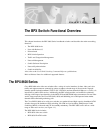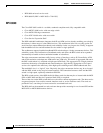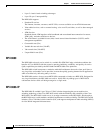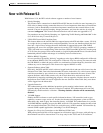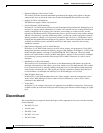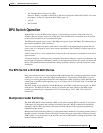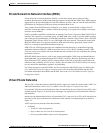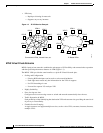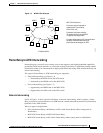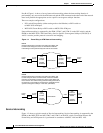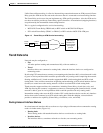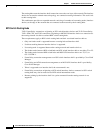
1-7
Cisco BPX 8600 Series Installation and Configuration
Release 9.3.10, Part Number 78-11603-01 Rev. D0, July 2001
Chapter 1 The BPX Switch: Functional Overview
BPX Switch Operation
• The Extended Services Processor (ESP)
However, PNNI is available on the BPX via the Service Expansion Shelf (SES) PNNI. For a brief
description, see Service Expansion Shelf PNNI, page 2-8.
• VSI 1.0
• The FastPAD
BPX Switch Operation
With the BCC-4 card, the BPX switch employs a non-blocking crosspoint switch matrix for cell
switchingthatcanoperateatupto19.2Gbpspeak.Theswitchmatrixcanestablishupto20million
point-to-point connections per second between ports.
The BXM cards support egress at up to 1600 Mbps and ingress at up to 800 Mbps. The enhanced egress
rate enhance operations such as multicast.
Access to and from the crosspoint switch matrix on the BCC is through multiport network and user
access cards. It is designed to easily meet current requirements with scalability to higher capacity for
future growth.
A BPX switch shelf is a self-contained chassis that may be rack-mounted in a standard 19-inch rack or
open enclosure.
All control functions, switching matrix, backplane connections, and power supplies are redundant, and
non-disruptive diagnostics continuously monitor system operation to detect any system or transmission
failure. Hot-standby hardware and alternate routing capability combine to provide maximum system
availability.
The BPX Switch with MGX 8220 Shelves
Many network locations have increasing bandwidth requirements due to emerging applications and the
confluence of voice, data, and video digital communications. To meet these requirements, you can
overlay your existing narrowband networks with a backbone of BPX switches to utilize the high-speed
connectivity of the BPX switch operating at up to 19.2 Gbps with its T3/E3/OC-3/OC-12 network and
service interfaces.
The BPX switch service interfaces include BXM ports on the BPX switch and service ports on MGX
8220 shelves. The MGX 8220 shelves may be co-located in the same cabinet as the BPX switch,
providing economical port concentration for T1/E1 Frame Relay, T1/E1 ATM, CES, and FUNI
connections.
Multiprotocol Label Switching
The BPX 8650 MPLS switch combines a BPX switch with a separate MPLS controller (Cisco Series
7200 router). By integrating the switching and routing functions, MPLS combines the reachability,
scalability, and flexibility provided by the router function with the traffic engineering optimizing
capabilities of the switch.
Multiprotocol Label Switching (MPLS) is a high-performance method for forwarding packets (frames)
through a network. It enables routers at the edge of a network to apply simple labels to packets (frames).
ATM switches or existing routers in the network core can switch packets according to the labels with
minimal lookup overhead.





